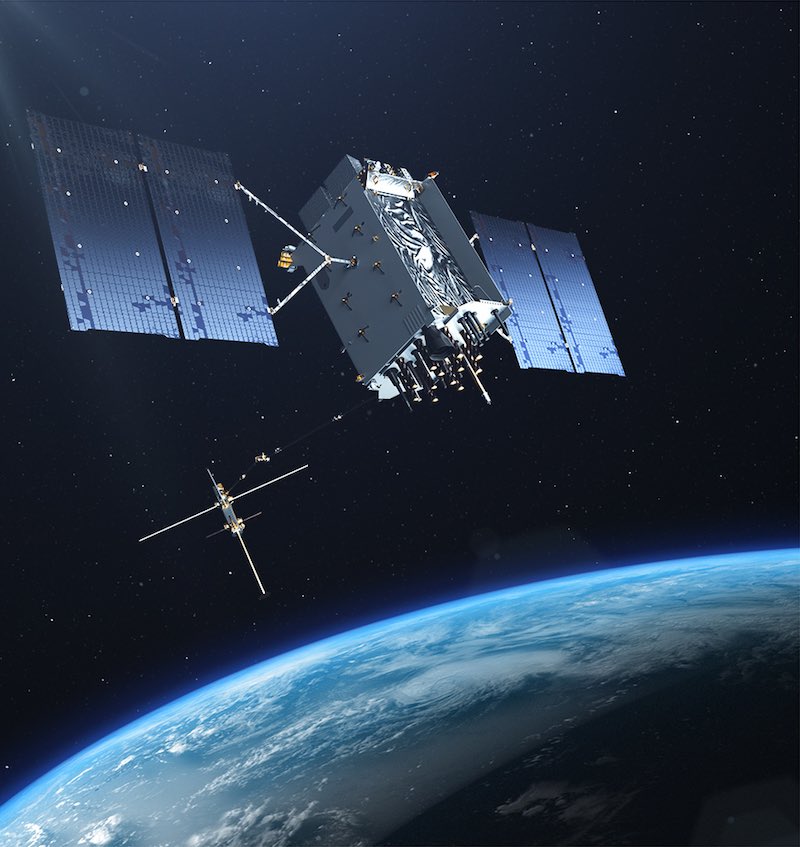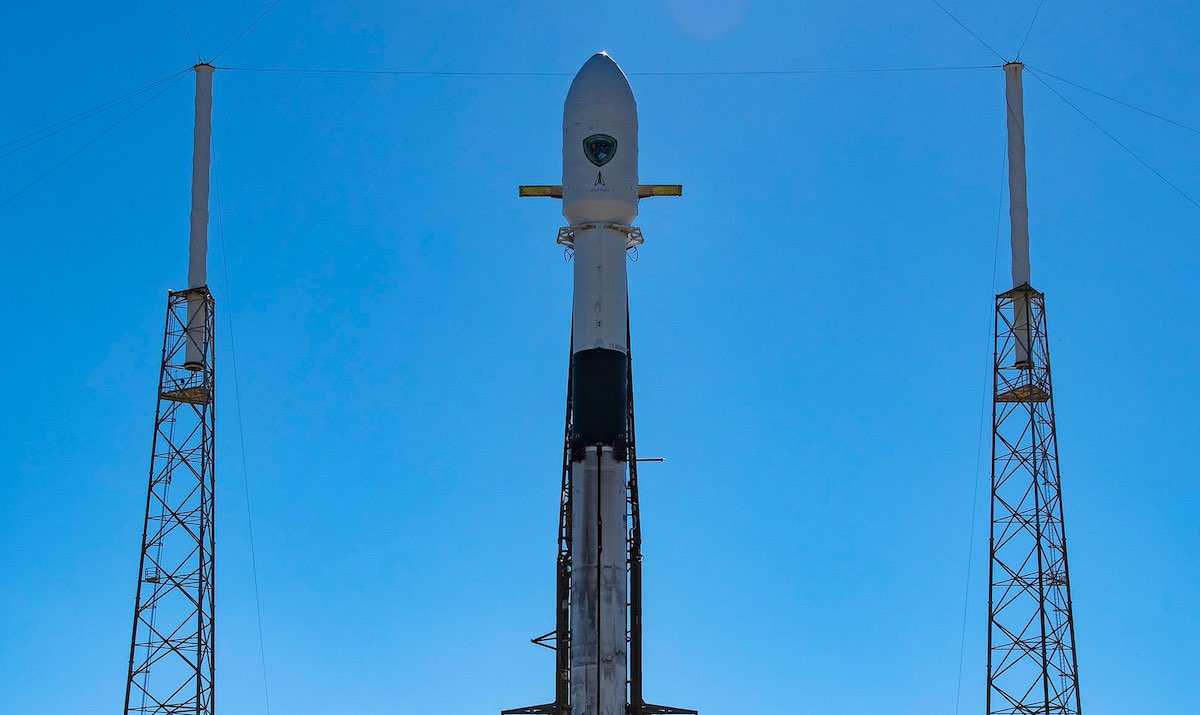
SpaceX’s second launch for the U.S. military in three days is set to blast off from Florida and deliver a GPS navigation satellite into orbit Wednesday, reinforcing the global positioning and timing network as four more GPS spacecraft are in storage at a Lockheed Martin factory in Colorado to be launched as needed over the next few years.
The launch of the U.S. Space Force’s GPS 3 SV06 mission — the sixth spacecraft in the latest generation of GPS 3-series satellites — is set for 7:10 a.m. EST (1210 GMT) Wednesday from pad 40 at Cape Canaveral Space Force Station in Florida. A SpaceX Falcon 9 rocket will give the satellite a ride into orbit. The Falcon 9 has a 15-minute launch window Wednesday.
The launch of the new GPS satellite Wednesday comes less than three days after a SpaceX Falcon Heavy rocket blasted off from Kennedy Space Center carrying two military satellites into geosynchronous orbit. That mission was successful, Space Force officials said.
Forecasters predict a greater than 90% chance of favorable weather Wednesday morning for liftoff of the Falcon 9 from Cape Canaveral, but officials will watch wind and sea conditions downrange in the booster recovery area. There is a moderate to high risk those conditions won’t be favorable for landing of the first stage, which could prompt SpaceX to delay the launch.
Once it lifts off, the 229-foot-tall (70-meter) Falcon 9 rocket will head northeast from Cape Canaveral to place the GPS 3 SV06 satellite at the proper altitude and inclination to reach a final operating position in the GPS constellation.
Following a standard launch profile, the Falcon 9 will fire its nine kerosene-fueled first stage engines for about two-and-a-half minutes. The booster will shut down and drop away from the Falcon 9’s upper stage, which will continue into orbit with the GPS satellite, first placing the payload into a parking orbit about eight minutes after liftoff.
At around the same time, the Falcon 9’s first stage booster — designed B1077 — will drop out of the sky and slow for landing on a SpaceX drone ship positioned a few hundred miles east of Charleston, South Carolina. The drone ship will bring the booster, set to make its second trip to space, back to Cape Canaveral for refurbishment and reuse on a future mission.
The payload fairing on top of the Falcon 9 will jettison a few moments after ignition of the upper stage engine for its first burn. SpaceX has dispatched a recovery ship into the Atlantic to also retrieve the two halves of the nose cone for reuse, after the aeroshells parachute into the sea.
About 63 minutes into the mission, the Falcon 9’s upper stage will reignite for about 44 seconds. The powerful engine, generating more than 200,000 pounds of thrust, will propel the GPS 3 SV06 spacecraft into an elongated orbit stretching to an altitude of some 12,550 miles (20,200 kilometers) at its highest point.
After flying into communications range of Space Force ground stations in Hawaii and California, the rocket will deploy the GPS satellite at about 1 hour and 29 minutes after liftoff.
Over the next one-to-two weeks, the satellite will use its own orbit-raising engine to maneuver into a circular Medium Earth Orbit 12,550 miles above Earth at an inclination of 55 degrees. If all goes according to plan, the new satellite, nicknamed “Amelia Earhart” after the aviation pioneer, will be transitioned to the control of Space Force operators.
The GPS 3 SV06 spacecraft is the sixth in a line of GPS 3-series satellites built by Lockheed Martin. In its launch configuration fully fueled with propellant, the satellite weighs 9,595 pounds (4,352 kilograms), according to Col. Jung Ha, senior materiel leader for the GPS Space Vehicles Acquisition Delta at Space Systems Command.
“The spacecraft is healthy and all systems are go,” Ha said Tuesday in a conference call with reporters.

Andre Trotter, Lockheed Martin’s vice president of navigation systems, said the company has four more GPS 3-series satellites ready for “call up” by the Space Force.
“We currently have four more GPS satellites in our Colorado facility that are available for launch and are prepared to answer the Space Force’s call,” Trotter told reporters Tuesday in a pre-launch news conference. Those satellites, numbered GPS 3 SV07 through SV10, are the final spacecraft in Lockheed Martin’s initial batch of GPS 3 satellites ordered by the Pentagon in 2008.
The next GPS satellite, GPS 3 SV07, is scheduled to launch in mid-2024 on a United Launch Alliance Vulcan rocket. It is a candidate to become the first national security payload to fly on ULA’s new Vulcan launch vehicle.
Construction of the first eight GPS 3 satellites is covered in a 2008 contract valued at $3.6 billion. The military ordered two additional GPS 3-type satellites later. The first GPS 3 satellite launched in 2018, and the most recent mission, SV05, launched in June 2021.
Military officials were unable to provide an exact cost for the GPS 3 SV06 spacecraft, but the average cost of each satellite in the 2008 purchase amounts to approximately $600 million in inflation-adjusted dollars.
The series of GPS 3 navigation satellites are designed for 15-year life spans, an improvement over the seven-and-a-half year and 12-year design lives of previous-generation GPS satellites. The GPS 3 satellites provide three times better accuracy and up to eight times improved anti-jamming capabilities over early GPS spacecraft, according to Lockheed Martin.
The GPS 3 satellites also introduce a new L-band civilian signal that is compatible with other international navigation satellite networks, such as Europe’s Galileo program. Combining signals from GPS, Galileo, and other navigation satellites can improve the precision of space-based position measurements.
The U.S. military uses GPS satellites for smart bombs and other precision-guided munitions. Troops rely on the network, which requires a minimum of 24 satellites for global coverage, to provide positioning data pole-to-pole.
Lockheed Martin won a follow-on contract from the military in 2018 to build up to 22 more upgraded GPS 3F satellites. The Space Force has placed firm orders with Lockheed Martin for the first 10 GPS 3F satellites, which will provide the military with new capabilities such as enhanced regional protection and even better anti-jamming capabilities, an upgraded search and rescue payload, and a laser retroreflector array to help provide more accurate data on each spacecraft’s location in orbit, information that will result in more precise position information for users on the ground.
L3Harris Technologies builds the navigation payloads for the GPS 3 satellites.
Civilians use the Global Positioning System on their smartphones, and airliners employ augmented GPS signals for precision landings and in-flight navigation. Banks use the timing signals from GPS satellites to time tag financial transactions.
“GPS has become a part of our critical national infrastructure,” Trotter said.
Email the author.
Follow Stephen Clark on Twitter: @StephenClark1.
